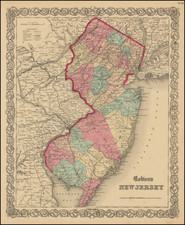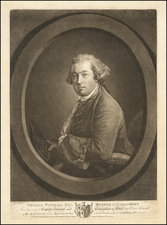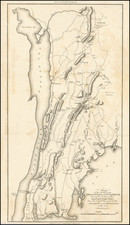Unique Contemporary Manuscript Plan of Battle which Secured George Washington’s Role as “Father of the Nation”
Finely-executed contemporary manuscript map of the Battle of Monmouth, the last major engagement of the Northern Theater of the American Revolution, drawn by a participant in the battle.
The map focuses on the main engagement of the battle, along the road to Englishtown; there was much maneuvering and skirmishing before and after the events depicted. It is rendered in black ink and wash, with highlights in red, blue, and green watercolor; it shows Freehold, New Jersey, Monmouth Court House, Freehold Court House, the roads and paths in the area, and the battlefield to the northwest. The well-positioned "Rebel" forces on a hill to the west are shown firing cannon on a flanked detachment of British Light Horse, Grenadiers, and Artillery. For most units, two positions are shown -- where they were at the outset of the battle, and where they were "after action.” Monmouth was the longest battle (excluding sieges) of the American Revolution.
The map depicts the latter half of the battle, after General Charles Lee's infamous miscarried initial assault on the British and George Washington's arrival on the scene. The action depicted started in the early-to-mid afternoon with the British attack on Washington’s line at Perrine’s Hill and the subsequent British retreat and conclusion of the battle.
The Battle of Monmouth took place on June 28th, 1778, as British forces were relocating en masse from Philadelphia to their new headquarters at New York. This was the first opportunity for the Continental Army to fight as a professional force, following a winter and spring of training at Valley Forge under Washington and von Steuben. This was a rare time that American forces held the battlefield (and both sides' wounded) after an engagement with the British. Although many modern historians view the battle as strategically inconclusive, at the time it was a major boost to American morale. American officers, the Continental Congress, and the American press interpreted the battle as a major success for the Continental Army, and for George Washington specifically. The action is seen as a coming of age for the Continental Army and it did much to elevate Washington to his role as “Father of the Nation.”
George Walker Dyall Jones
The map is signed in the lower left margin "Lieut. Jones Royal Fusileers". This is surely George Walker Dyall Jones, the only lieutenant by the name of Jones recorded with the 7th Regiment of Foot, Royal Fusiliers, during the American Revolution.
The son of Andrew and Elizabeth Jones of Warwick, United Kingdom, Jones was baptized on the 19th of April 1745. He apprenticed as a toy-maker to Edward Gibbons of Birmingham in 1759. Jones married Sophie Zincke of Lambeth at Westminster March 12, 1771, but the marriage seems to have been ill-fated. They had a son, Christian Dyall Jones, who was born and died at Lambeth in 1772, and the couple divorced in 1795.
The timing of Jones' early military career is somewhat difficult to parse, with different sources offering somewhat conflicting information. Suffice it to say that in 1772 he entered the 44th Regiment of Foot as an Ensign, and in 1778 or 1779 was promoted to Lieutenant and shifted to the 7th Regiment, also known as the Royal Fusiliers. The exact timing of this is not clear, but the essential point is that both the 44th and the 7th were present at Monmouth, making it highly likely that Jones was a participant in the events depicted on this plan of the battle.
In the capacity of assistant engineer under one Captain Hartcup, Jones later accompanied an expedition in 1780 under Sir George Collier to reinforce the post at Castine, Maine. This deployment yielded five manuscript maps and views bearing his name, representing Jones’ entire known output, save for the present plan of Monmouth. Guthorn, in British Maps of the American Revolution, gives his output as follows:
- A front view of Fort George Majabigwaduce June 1780. By: G.W. Dyail Jones, asst. engineer. Finished manuscript elevation and ground plan 10¼ by 2¼ and 23 by 4. Clements Library. Brun 153.
- A plan, profile and front view of Fort George Majabigwaduce. G.W. Dyail Jones asst. engineer. Careful, finished manuscript 2¼ by 11 and 4 by 23¾. Clements Library. Brun 158.
- Sketch of the neck and Harbour of Majabigwaduce. G.W.D. Jones asst: engr. August. 22d. 1779. Finished, colored manuscript 19 x 12 3/8. Clements Library. Brun 159.
- Sketch of the neck and Harbour of Majabigwaduce 20th. Aug 1779 G.W.D. Jones. Finished, colored manuscript 19 by 21½. Clements Library. Brun 160.
To this list, we can add a hand-drawn view from the same deployment:
5. "View of Fort George, by G.W.D. Jones. 1780." [title supplied] Bangor Public Library, Maine.
Other maps and plans of the Battle of Monmouth
Until now, the formal British mapping of the Battle of Monmouth was known exclusively from the manuscript maps of John Hills (fl. 1777-1816/17), a British military engineer, surveyor and draughtsman. Hills produced at least four manuscript maps focusing specifically on the Battle of Monmouth, three of which are held at the Library of Congress (LC G3812.M64S3 1778 .H51, LC G3812.M64S3 1778 .H5, LC G3812.M64S3 1778 .H5) and the fourth at the Clements (Clinton Papers, Brun 512).
Hills was attached to the 38th Regiment of Foot in June 1778. At that time, the 38th was stationed in New York City, and it had no direct involvement in the Battle of Monmouth. When the 44th decamped to Rhode Island later in 1778, Hills remained in New York and began his employment as a draftsman under John Montresor, the Chief Engineer of British forces in North America. Indeed, it seems that most of Hills produced most of his output came while stationed in New York, an opportune location for gathering, compiling, and copying maps, but not particularly for surveying and drawing original works.
While Hills’ and Jones’ plans of Monmouth bear a certain similarity, Hills’ works all share a title that differs somewhat from that of Jones, cover a rather larger area in the direction of Middletown, and include an inset “Sketch” of Middletown itself. These significant differences, coupled with a great number of smaller differences in how the events themselves are depicted, strongly suggest that the Jones and Hills maps are based on different sources. Given that Jones’ unit, the 44th, was actually present at Monmouth, while Hills was with the 38th in New York, we are inclined to assign priority to this map by Jones.
Michel Captain du Chesnoy (1746-1804), a member of Lafayette’s staff, drew a detailed eyewitness plan of the battle, which is now held by the Library of Congress (LC G3812.M64S3 1778 .C3). This was the source for the only early printed map of the battle (LC G3812.M64S3 1782 .P5), which was published in Brussels in 1782.









![[Autographs of British Admirals During the American Revolution & War of 1812]](https://storage.googleapis.com/raremaps/img/small/69274.jpg)




![[ Revolutionary War Boston ] Carte Particuliere Du Havre De Boston . . . 1780](https://storage.googleapis.com/raremaps/img/small/61227.jpg)